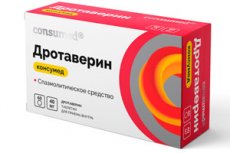Drotaverine
阿列克謝·克雷文科 ,醫學編輯
最近審查:04.07.2025
最近審查:04.07.2025

屈他维林(商品名No-Spa)是一种用于缓解人体内部器官平滑肌痉挛和收缩的药物。其主要活性成分是盐酸屈他维林。
屈他维林能够放松腹部器官、血管和泌尿道的平滑肌。它常用于缓解各种疾病的症状,例如:
屈他维林通常以片剂或胶囊形式口服。具体剂量和用法可能因患者个人需求和医生建议而异。
適應症 Drotaverine
- 腹痛:屈他维林可用于缓解与胃或肠痉挛和痉挛相关的疼痛,例如绞痛。
- 胆囊和胆管疼痛:该药物可用于缓解与胆囊或胆管痉挛相关的疼痛。
- 痛经:屈他维林有助于缓解女性痛经,从而减轻月经期间疼痛的强度和持续时间。
- 膀胱症状:该药物可用于缓解膀胱痉挛和不适症状。
- 血管痉挛症状:屈他维林可以帮助缓解血管痉挛,改善引起疼痛症状的血液循环。
發布表單
- 片剂:这是屈他维林最常见的剂型。片剂口服,通常用水送服,有多种剂量,可根据患者的个人需求选择最佳剂量。
- 注射液:对于需要更快起效或无法口服的情况,屈他维林可以注射液形式给药。该溶液通常由医务人员静脉或肌肉注射。
藥效學
屈他维林是一种肌力解痉药。其药效学与其舒张血管和内脏器官(尤其是肠道、泌尿道和子宫)平滑肌的能力有关。
该药物通过阻断磷酸二酯酶起作用,导致平滑肌细胞中环磷酸腺苷(cAMP)水平升高。这反过来又导致血管舒张和内脏器官平滑肌张力降低,从而改善血液供应并缓解痉挛症状。
屈他维林还具有血管解痉作用,可导致外周动脉和静脉扩张,改善血液循环,降低外周阻力。
藥代動力學
- 吸收:屈他维林经胃肠道吸收,口服后一般1-2小时达最高血药浓度。
- 分布:屈他维林广泛分布于全身组织,包括中枢神经系统和发生痉挛的器官。屈他维林可穿透血脑屏障。
- 代谢:屈他维林在肝脏中代谢为无活性的代谢物,主要代谢物为N-氧化物和N-去甲基化屈他维林。
- 排泄:屈他维林及其代谢物主要经肾脏排出体外。排出的代谢物通常为结合形式。
- 半衰期(t½):屈他维林的半衰期约为4小时。老年患者中,半衰期可能略有延长。
- 蛋白质结合:屈他维林与血浆蛋白的结合程度较小(约80%)。
劑量和管理
- 片剂或胶囊:屈他维林通常每次服用40-80毫克(1-2片或胶囊),每日最多三次。但医生可能会根据症状严重程度和患者的个人需求调整具体剂量。片剂或胶囊通常在餐前服用,如有需要,可用少量水送服。
- 注射液:对于无法口服或口服无效的情况,医务人员可以静脉或肌肉注射屈他维林。注射液剂量通常为40-80毫克(1-2支安瓿),每日最多三次。
在懷孕期間使用 Drotaverine
在怀孕期间使用屈他维林(No-Spa)之前,请务必咨询医生。医生应评估该药物对母亲的益处以及对胎儿的潜在风险。
关于孕期使用屈他维林的安全性数据有限。尽管动物研究尚未显示其对胎儿发育有毒性作用,但关于该药在孕妇中的使用数据有限,且其使用建议也各不相同。
医生只有在治疗益处大于潜在风险的情况下,才会为孕妇开具屈他维林处方。医生也可考虑采用替代疗法,或在妊娠期间使用其他临床经验更丰富的药物。
禁忌
- 已知个体对该药物不耐受。
- 严重的肝脏或肾脏功能障碍。
- 低血压(低血压)。
- 心脏衰竭。
- 胃肠道急性出血。
- 心动过速(心率过快)。
- 闭角型青光眼。
- 重症肌无力(一种以骨骼肌无力和疲劳为特征的疾病)。
- 膀胱或肠道张力减退(无力)。
- 既往心肌梗塞(尤其是急性期)。
- 怀孕(特别是在妊娠初期)和哺乳期(哺乳期)。
副作用 Drotaverine
- 嗜睡和头晕:这些症状可能是服用屈他维林时最常见的症状。它们可能会影响注意力和某些活动的能力,例如驾驶。
- 头痛和虚弱:一些患者服用屈他维林后可能会出现头痛或虚弱感。
- 胃肠道疾病:包括恶心、呕吐、腹泻或便秘等症状。
- 过敏反应:在极少数情况下,屈他维林可能会引起皮疹、瘙痒或血管性水肿等过敏反应。
- 血压降低:在某些患者中,屈他维林可能会导致血压下降,表现为低血压,并可能使现有的心血管问题恶化。
- 口干:这也是服用屈他维林的常见副作用。
- 心动过速:部分患者服药后可能会出现心跳加快或心悸的感觉。
過量
- 头晕、虚弱、头痛、嗜睡、恶心、呕吐、血压下降等副作用增加。
- 心律失常,如心动过速或心律失常。
- 腹泻或便秘等胃肠道疾病。
與其他藥物的相互作用
- 抗胆碱药物:屈他维林与其他抗胆碱药物(如阿托品或东莨菪碱)同时使用可能会增强其作用并增加口干或便秘等副作用的风险。
- 中枢作用药物:屈他维林可能会增强镇静剂或止痛剂等中枢作用药物的作用。这可能会导致嗜睡加剧或反应速度减慢。
- 降血压药物:屈他维林与抗高血压药物如β受体阻滞剂或血管紧张素转换酶抑制剂(ACEI)同时使用可能会增强其降压作用并导致血压下降。
- 延长QT间期的药物:屈他维林可能会增强影响QT间期的药物(例如抗心律失常药物或大环内酯类抗生素)的延长作用。这可能会增加发生心律失常的风险。
- 通过细胞色素 P450 代谢的药物:屈他维林可能会影响通过肝酶细胞色素 P450 代谢的其他药物的代谢,从而导致其血液浓度升高或降低。
注意!
為了簡化對信息的理解,本指令使用了藥物 "Drotaverine",並根據藥物的醫療用途官方說明。 使用前請閱讀直接用於藥物的註釋。
描述僅供參考,不適用於自我修復指導。 這種藥物的需求,治療方案的目的,藥物的方法和劑量僅由主治醫師確定。 自我藥療對你的健康有危害。

